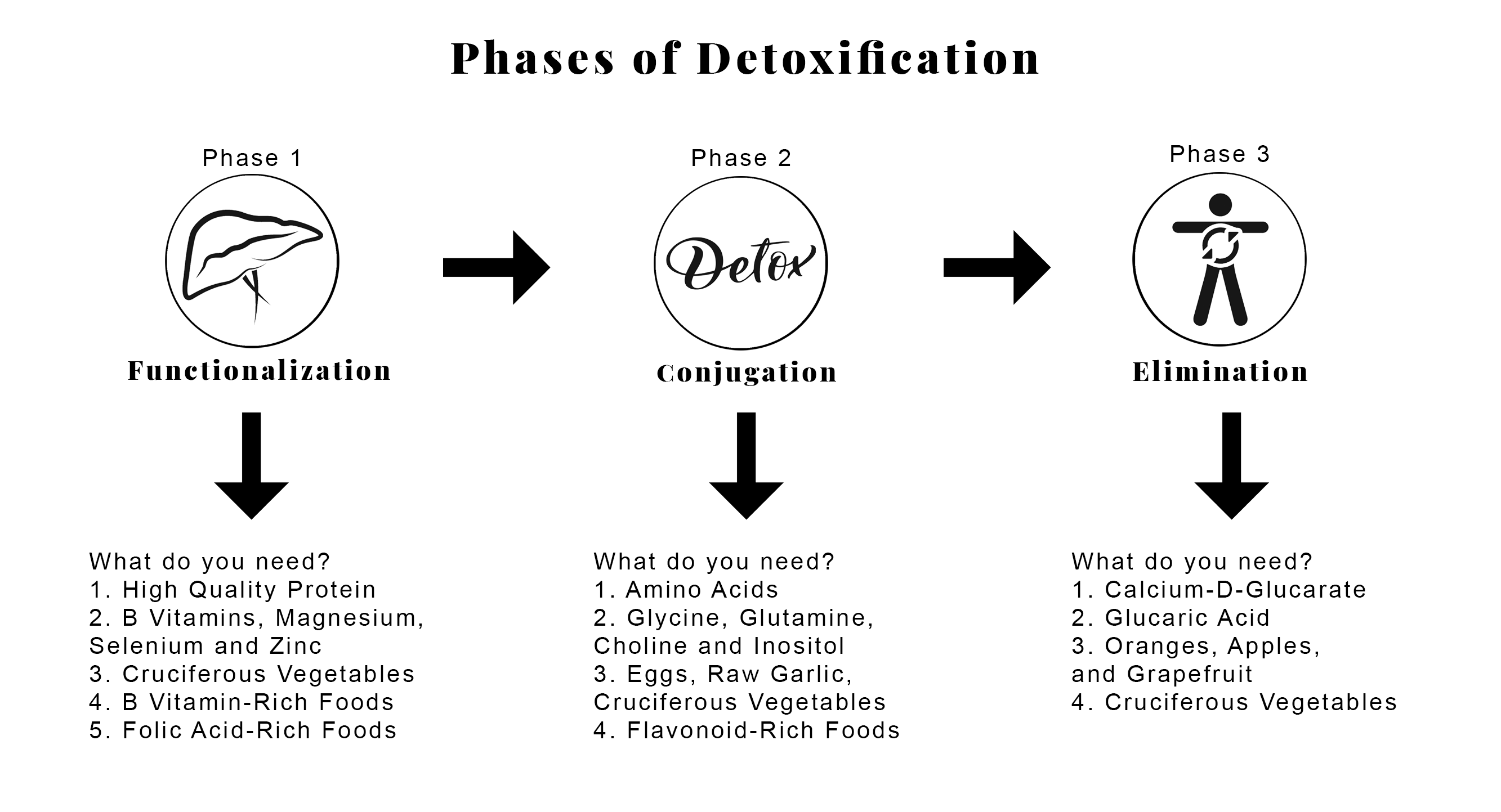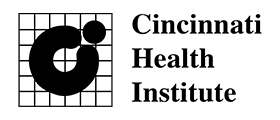Phases of Detoxification
Jan 31st 2023

True Detoxification Will Address All 3 Phases
What happens in Phase 1?
In the first phase of detoxification, the goal is to transform lipid-based toxins (most toxins are lipid-based) that have accumulated in the cell, into water-soluble toxins, using biotransforming enzymes that can catalyze (induce) the oxidation, reduction, and hydrolysis of the toxins.
The Cytochrome-P450 enzyme group is largely responsible for this process of:
- transforming the toxins to be more water soluble for excretion and
- transforming them to be bound with other molecules in phase 2 to make them even more, water-soluble for easier excretion.
Phase 1 is fully dependent on the cytochrome-P450 enzymes, whose speed of metabolism is affected by things like genetics, exercise, and the presence or absence of certain substances/supplements in the diet that can either speed them up (induce them) or slow them down (inhibit them).
After being acted upon by the Cp-450 enzymes, they become free radicals; if not enough phase 2 enzymes act quickly upon them, they can do secondary cellular damage to the body.
If Phase 1 and Phase 2 are not in balance, i.e. there aren't enough Phase 2 enzymes to process the products of Phase 1, you run the risk of increasing free radical damage and having your body become MORE toxic.
A high-quality detox program that balances and induces the proper enzymes in phases 1 and 2 is helpful. A detox program that only stimulates or supports one detoxification pathway or that ends prematurely can have the opposite effect of detoxification and can bombard your system with unwanted and harmful free radicals.
What natural products induce or enhance the action of Phase 1?
Phase 1 and the Cp-450 enzymes require certain nutrients be present to effectively prepare them for Phase 2. High-quality protein sources are essential, as too little can hinder Cp-450 activity. In addition, the body must have adequate amounts of magnesium, selenium, zinc and B vitamins. Phase 1 produces free radicals that require antioxidants like vitamins E, C, and various carotenoids.
No matter the detox program you choose, if these things are not present in sufficient amounts, you will not experience an optimal detox.
What happens in Phase 2?
Phase 2 is called the conjugation pathway because it takes the products from Phase 1 and binds them with Phase 2 substances (conjugates) to render them less harmful and more water soluble for easier excretion.
Phase 2 conjugates include amino acids, sugars, glutathione (which is stimulated by N-Acetyl-Cystine), methionine, sulfur (found in garlic, onions, and cruciferous vegetables like broccoli and cabbage), and acetyl Co-A. Phase 2 must be working quickly and efficiently after Phase 1, as there is growing scientific evidence suggesting that certain diseases are the direct result of damage to the body from poor Phase 2 detoxification. Some of the diseases that may be caused by toxic intermediate metabolites and free radicals include cancer, Parkinson's disease, fibromyalgia, chronic fatigue, lupus, and immune dysfunction.
Phase 2 enzymes work to further enhance solubility and reduce toxicity. Through conjugation, the liver can turn drugs, hormones, and various toxins into water-soluble, excretable substances.
What natural products enhance Phase 2 detoxification?
For efficient Phase 2 detoxification, the liver cells require sulfur-containing amino acids such as taurine and cysteine. The nutrients glycine, glutamine, choline, and inositol are also required for this step.
Eggs and cruciferous vegetables (eg. broccoli, cabbage, Brussels sprouts, cauliflower), raw garlic, onions, leeks, and shallots are all useful sources of natural sulfur compounds to enhance Phase 2 detoxification. Thus, these foods can be considered to have a cleansing action.
While it is always best to get what you need from a healthy, varied diet, it isn’t always possible to feed the body enough of these nutrients when considering the optimal amount that the body requires to detoxify (especially if you are experiencing toxic overload). Phase 2 detoxification needs to be fed the proper conjugates (amino acids, nutrients like glycine, glutamine, choline, and inositol) to transform the Phase 1 intermediates into compounds that can be excreted.
This is a common roadblock for many attempting to cleanse or detoxify and a legitimate reason to consider a comprehensive detoxification program from a reputable nutrition company.
What happens in Phase 3?
Phase 3 is commonly referred to as the waste removal and excretion phase.
During Phase 3, the conjugates from Phase 2 (which are now water soluble and have been reduced in toxicity) are ready to be removed from the body. They are pumped into the bile and intestinal lumen to be processed and eliminated. In this portion of detoxification, a healthy gut is imperative.
If you have an imbalance of healthy bacteria vs. bad bacteria (E. Coli, Clostridium), the bad bacteria can produce enzymes like beta-glucuronidase that deconjugate (unbind) the Phase 2 compounds, making them impossible to eliminate and sending them back to be processed again and again by the liver. This increases a person’s toxic load, and the negative feedback loop can be a harbinger of weird symptoms and disease states, which is why proper detoxification is often our doctor's first suggestion in treatment.
What natural products can enhance Phase 3?
Research has shown that calcium-D-glucarate and glucaric acid -- found in various fruits and vegetables including oranges, apples, grapefruit, and cruciferous vegetables -- inhibit beta-glucuronidase, thereby supporting detoxification. Silymarin, a constituent of milk thistle, also inhibits the enzyme beta-glucuronidase.
What can I do to support detoxification?
As you can see, there is a lot more to proper detoxification than simply fasting, cleaning up your diet, or drinking a special drink. It requires each of the 3 phases to be supported by proper minerals, nutrients, and antioxidants. The first step for anyone interested in detoxing should be a quality detoxification program that addresses them all. Once this is accomplished, you can start more targeted detoxification support. For instance, perhaps you know you have had high exposure to heavy metals; some products can target those and support their healthy elimination. Whatever your circumstances may be, rest assured there is a product to support them.
We like the OmniCleanse Whole Body Detoxification Program -- It covers all aspects of detoxification and adequately supports the body’s natural processes to give you the best chance of reducing your toxic load.
This system covers all aspects of integrative nutrition: homeopathic, botanical, and nutritional, giving you the very best in whole-body detoxification. We also have great detox protocols from Systemic Formulas, Designs for Health, Biotics, and more. Go to our detox page to check out all our detox programs and targeted detoxification products.

